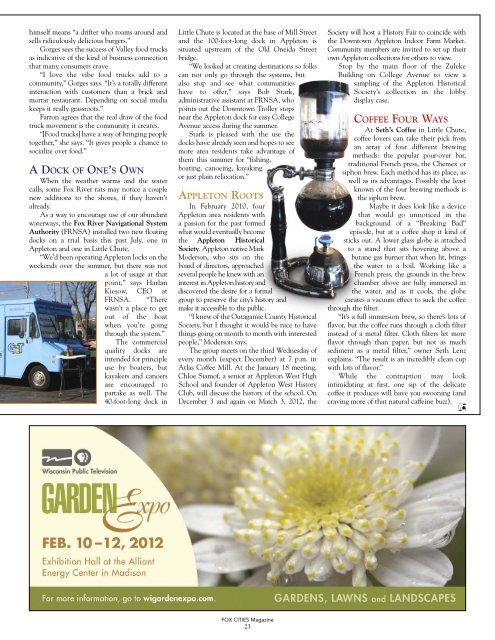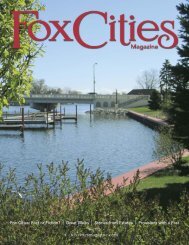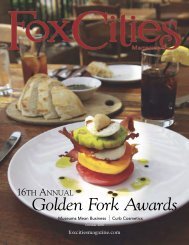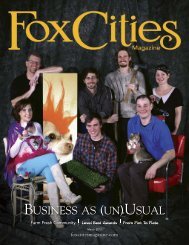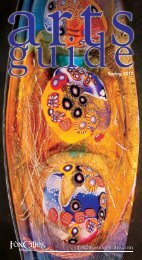127 FCM COVER - Fox Cities Magazine
127 FCM COVER - Fox Cities Magazine
127 FCM COVER - Fox Cities Magazine
Create successful ePaper yourself
Turn your PDF publications into a flip-book with our unique Google optimized e-Paper software.
himself means “a drifter who roams around and<br />
sells ridiculously delicious burgers.”<br />
Gorges sees the success of Valley food trucks<br />
as indicative of the kind of business connection<br />
that many consumers crave.<br />
“I love the vibe food trucks add to a<br />
community,” Gorges says. “It’s a totally different<br />
interaction with customers than a brick and<br />
mortar restaurant. Depending on social media<br />
keeps it really grassroots.”<br />
Farron agrees that the real draw of the food<br />
truck movement is the community it creates.<br />
“[Food trucks] have a way of bringing people<br />
together,” she says. “It gives people a chance to<br />
socialize over food.”<br />
A DOCK OF ONE’S OWN<br />
When the weather warms and the water<br />
calls, some <strong>Fox</strong> River rats may notice a couple<br />
new additions to the shores, if they haven’t<br />
already.<br />
As a way to encourage use of our abundant<br />
waterways, the <strong>Fox</strong> River Navigational System<br />
Authority (FRNSA) installed two new floating<br />
docks on a trial basis this past July, one in<br />
Appleton and one in Little Chute.<br />
“We’d been operating Appleton locks on the<br />
weekends over the summer, but there was not<br />
a lot of usage at that<br />
point,” says Harlan<br />
Kiesow, CEO at<br />
FRNSA. “There<br />
wasn’t a place to get<br />
out of the boat<br />
when you’re going<br />
through the system.”<br />
The commercial<br />
quality docks are<br />
intended for principle<br />
use by boaters, but<br />
kayakers and canoers<br />
are encouraged to<br />
partake as well. The<br />
40-foot-long dock in<br />
Little Chute is located at the base of Mill Street<br />
and the 100-foot-long dock in Appleton is<br />
situated upstream of the Old Oneida Street<br />
bridge.<br />
“We looked at creating destinations so folks<br />
can not only go through the systems, but<br />
also stop and see what communities<br />
have to offer,” says Bob Stark,<br />
administrative assistant at FRNSA, who<br />
points out the Downtown Trolley stops<br />
near the Appleton dock for easy College<br />
Avenue access during the summer.<br />
Stark is pleased with the use the<br />
docks have already seen and hopes to see<br />
more area residents take advantage of<br />
them this summer for “fishing,<br />
boating, canoeing, kayaking<br />
or just plain relaxation.”<br />
APPLETON ROOTS<br />
In February 2010, four<br />
Appleton area residents with<br />
a passion for the past formed<br />
what would eventually become<br />
the Appleton Historical<br />
Society. Appleton native Mark<br />
Moderson, who sits on the<br />
board of directors, approached<br />
several people he knew with an<br />
interest in Appleton history and<br />
discovered the desire for a formal<br />
group to preserve the city’s history and<br />
make it accessible to the public.<br />
“I knew of the Outagamie County Historical<br />
Society, but I thought it would be nice to have<br />
things going on month to month with interested<br />
people,” Moderson says.<br />
The group meets on the third Wednesday of<br />
every month (expect December) at 7 p.m. in<br />
Atlas Coffee Mill. At the January 18 meeting,<br />
Chloe Siamof, a senior at Appleton West High<br />
School and founder of Appleton West History<br />
Club, will discuss the history of the school. On<br />
December 3 and again on March 3, 2012, the<br />
FOX CITIES <strong>Magazine</strong><br />
23<br />
Society will host a History Fair to coincide with<br />
the Downtown Appleton Indoor Farm Market.<br />
Community members are invited to set up their<br />
own Appleton collections for others to view.<br />
Stop by the main floor of the Zuleke<br />
Building on College Avenue to view a<br />
sampling of the Appleton Historical<br />
Society’s collection in the lobby<br />
display case.<br />
COFFEE FOUR WAYS<br />
At Seth’s Coffee in Little Chute,<br />
coffee lovers can take their pick from<br />
an array of four different brewing<br />
methods: the popular pour-over bar,<br />
traditional French press, the Chemex or<br />
siphon brew. Each method has its place, as<br />
well as its advantages. Possibly the least<br />
known of the four brewing methods is<br />
the siphon brew.<br />
Maybe it does look like a device<br />
that would go unnoticed in the<br />
background of a “Breaking Bad”<br />
episode, but at a coffee shop it kind of<br />
sticks out. A lower glass globe is attached<br />
to a stand that sits hovering above a<br />
butane gas burner that when lit, brings<br />
the water to a boil. Working like a<br />
French press, the grounds in the brew<br />
chamber above are fully immersed in<br />
the water, and as it cools, the globe<br />
creates a vacuum effect to suck the coffee<br />
through the filter.<br />
“It’s a full immersion brew, so there’s lots of<br />
flavor, but the coffee runs through a cloth filter<br />
instead of a metal filter. Cloth filters let more<br />
flavor through than paper, but not as much<br />
sediment as a metal filter,” owner Seth Lenz<br />
explains. “The result is an incredibly clean cup<br />
with lots of flavor.”<br />
While the contraption may look<br />
intimidating at first, one sip of the delicate<br />
coffee it produces will have you swooning (and<br />
craving more of that natural caffeine buzz).


